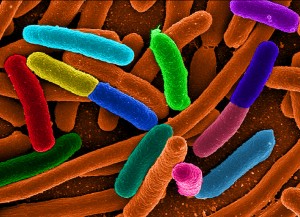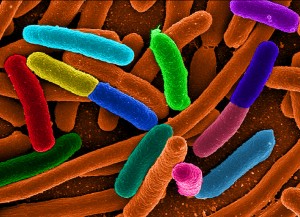Authors answer questions on new study, which shows that exposure to Roundup and other herbicides could contribute to antibiotic resistant disease.
A new study has found that exposure to the herbicides used on GM crops changes how susceptible disease-causing bacteria are to antibiotics. In many cases the bacteria became more antibiotic-resistant, though in other cases they became less so. The study was carried out by Prof Jack Heinemann, Dr Brigitta Kurenbach, and other scientists from New Zealand and Mexico. Below Prof Heinemann and Dr Kurenbach respond to questions from GMWatch.
GMW: What did you find?
Heinemann: When we exposed either of two different species of bacteria to common herbicides that we purchased at a local store, we found that the bacteria changed their response to antibiotics. They often became antibiotic resistant, but we also occasionally saw increased susceptibility or no effect.
GMW: Which herbicides and antibiotics are you talking about?
Kurenbach: We tested commercial formulations of herbicides based on the active ingredients dicamba, 2,4‑D and glyphosate. The antibiotics were representative of five major groups: β‑lactams (ampicillin), chloramphenicol, tetracycline, fluroquinolones (ciprofloxacin) and aminoglycosides (kanamycin).
GMW: Why does your study matter?
Heinemann: Every day you see in the news that there are concerns about the ever increasing frequency of antibiotic resistance in bacteria that can cause disease in people and our animals. Anything that contributes to this problem should be considered because new antibiotics are rare.
Kurenbach: The effects found may be relevant if people or animals are exposed to herbicides at the higher ranges of concentration, those that occur when it is applied rather than what is normally found on food. Those kinds of exposures may be experienced by, for example, farm animals and pollinators in rural areas and potentially children and pets in urban areas.
Heinemann: And we can’t predict either the direction or size of the observed effects based on bacterial species, antibiotic or herbicide used. Thus, different potential disease-causing bacteria may react differently to the same herbicide or to the same antibiotic.
GMW: Is this the first study to show this?
Kurenbach: We’ve looked hard to find other studies like this, but haven’t found any. Other studies have reported on other substances that also change bacteria’s tolerance to antibiotics (e.g. aspirin), but herbicides weren’t used.
GMW: What are the limitations of your study?
Heinemann: While we tested examples from most major groups of antibiotics, there are more individual antibiotics than we could test. And our tests are in the laboratory. We hope to get funding to test environmental samples or bacteria from animals.
Kurenbach: We only tested two species of bacteria. They were laboratory strains of disease-causing species. We’d like to test the response of more species of bacteria.
We provide genetic and biochemical evidence of how the bacteria become resistant or sensitive. But there may be more ways than we have so far described.
GMW: Have these results been replicated?
Heinemann: As part of this study we engaged another scientist at another university in a blinded replication. We sent her the bacteria and chemicals through an intermediary who kept their identities a secret. Using our protocols, she was able to confirm our findings. She also later joined the author team.
—
The study
Sublethal Exposure to Commercial Formulations of the Herbicides Dicamba, 2,4‑Dichlorophenoxyacetic Acid, and Glyphosate Cause Changes in Antibiotic Susceptibility in Escherichia coli and Salmonella enterica serovar Typhimurium
Brigitta Kurenbach, Delphine Marjoshi, Carlos F. Amábile-Cuevas, Gayle C. Ferguson, William Godsoe, Paddy Gibson, Jack A. Heinemann
mBio 6(2):e00009-15. doi:10.1128/mBio.00009–15.
ABSTRACT Biocides, such as herbicides, are routinely tested for toxicity but not for sublethal effects on microbes. Many biocides are known to induce an adaptive multiple-antibiotic resistance phenotype. This can be due to either an increase in the expression of efflux pumps, a reduced synthesis of outer membrane porins, or both. Exposures of Escherichia coli and Salmonella enterica serovar Typhimurium to commercial formulations of three herbicides — dicamba (Kamba), 2,4‑dichlorophenoxyacetic acid (2,4‑D), and glyphosate (Roundup) — were found to induce a changed response to antibiotics. Killing curves in the presence and absence of sublethal herbicide concentrations showed that the directions and the magnitudes of responses varied by herbicide, antibiotic, and species. When induced, MICs of antibiotics of five different classes changed up to 6‑fold. In some cases the MIC increased, and in others it decreased. Herbicide concentrations needed to invoke the maximal response were above current food maximum residue levels but within application levels for all herbicides. Compounds that could cause induction had additive effects in combination. The role of soxS, an inducer of the AcrAB efflux pump, was tested in -galactosidase assays with soxSlacZ fusion strains of E. coli. Dicamba was a moderate inducer of the sox regulon. Growth assays with Phe-Arg -naphtylamide (PA N), an efflux pump inhibitor, confirmed a significant role of efflux in the increased tolerance of E. coli to chloramphenicol in the presence of dicamba and to kanamycin in the presence of glyphosate. Pathways of exposure with relevance to the health of humans, domestic animals, and critical insects are discussed.
IMPORTANCE Increasingly common chemicals used in agriculture, domestic gardens, and public places can induce a multiple antibiotic resistance phenotype in potential pathogens. The effect occurs upon simultaneous exposure to antibiotics and is faster than the lethal effect of antibiotics. The magnitude of the induced response may undermine antibiotic therapy and substantially increase the probability of spontaneous mutation to higher levels of resistance. The combination of high use of both herbicides and antibiotics in proximity to farm animals and important insects, such as honeybees, might also compromise their therapeutic effects and drive greater use of antibiotics. To address the crisis of antibiotic resistance requires broadening our view of environmental contributors to the evolution of resistance.



